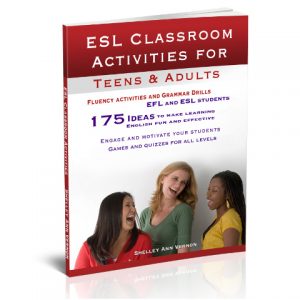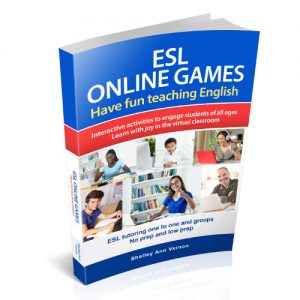Hello there, and thanks for visiting this page on teaching English online. The activities here suit any creative online class, even when students are stuck at home in case they have the flu but don’t know it.
If you already own my fun classroom activities for teens and adults, here is a list of games adaptable to online teaching: Online-Activities-for-Teens-and-Adults-Shelley-Ann-Vernon
On the other hand, if you are exclusively teaching English online, ESL Online Games is the book you need. It’s absolutely packed with great activities for all ages, from six to adults.
Online teaching ideas
If you are teaching English online from home, via Skype, Zoom, or another platform, try these ideas to liven up your classes. And, if you like this blog and have a tip, please share it in the comments!
Creative writing diary project
Students recount something nice or funny every day, maybe with a picture. Then, they compare notes on what they did in the online class.
Something original
Have a competition to see who can do the most original or nice thing in their day and get the others to vote on it. See who can do something that no one else has done! For example, it might be making some biscuits with a unique or flavour. Or, it might be skateboarding in the basement. Students have to prove it – by showing a biscuit in the online class or showing a photo. Otherwise, they could say anything.
Even though you are teaching English online, get students away from technology for some of the time. Indeed, it’s well-known that lack of exercise and too much screen time can cause depression amongst the young. So let’s get students to be creative away from their phones and social media.
Art and creative projects
How about running an art project in English? For example, give students tips and know-how on taking creative photos. Students learn about this in English, and each one submits a picture or two to the pool anonymously. Then, all students vote on their favourites. At the end, the winners can be identified, if you like.
However, creative pictures don’t have to be exotic but can be everyday objects. For example, who can take the most creative photo of a book? Taking close-ups can be fun because it can be hard to tell what it is if you photograph part of an object. So have a close-up competition, a guessing game, using photos students submit. Can you tell what the thing is? The first two pictures are pretty easy to guess but the answers are at the bottom of the blog if you need them.

Tip
Students should submit their photos anonymously to avoid the social media ‘we like sheep’ phenomenon, where you ‘like’ the picture taken by your mate even if it’s a load of rubbish because if you don’t, they will never speak to you again!
Origami instructions
How about giving students instructions in English to do some origami? Students can each make a different model and show it in the following online class. They could have the task then of creating a story, collectively, that involves each of the items made. Or, each student makes up a story with his or her origami object as the hero/heroine.
Grow or make things
Ongoing projects that students share with the class could be to plant lettuce seeds in a pot at home. Even if there isn’t much space at home or in class, you can still grow lettuce by a window in a salad bowl. It’s also therapeutic to grow things. Of course, some students may not be able to do this, in which case, let them choose another project to create and share.
Dressing up project
How about a dressing-up project? Each student creates an outfit, from their regular clothes, with some makeup and a prop or two. They attend class in their costume (if you use cameras) or send in a picture. Everyone guesses who the others are. Students can then present their character and say a few lines about them, who they are, why they like them, what they have done that is significant. It can be anything – give students free rein. If someone wants to disguise themselves as their cat, why not? They can still tell you why they chose their pet and what they like about it.
Personally, I would be useless at this disguise task, and I would not even enjoy doing it. But, on the other hand, doing something like the Armenian artist Edgar Artis would appeal more to me. He is into making dresses with everyday objects from salad to matches. So it’s crucial to give your students a choice of activity.
(Get ideas from Edgar Artis’ Instagram page)
Plays and skits
Reading scripts in small groups or one on one can be an excellent activity. It might be too much of a drag with a large class unless you can do group work online. That said, some fun could be had with pronunciation practise, and putting expression into speech. Working on expression is brilliant for speaking fluency and confidence too. So, take a couple of lines from a play and have students put as much energy and feeling into the lines as they can. Explore different ways that the lines can be said, such as disdain, questioning, joy, laughter, hesitancy, and sadness. Try emphasizing certain words in the sentence and see how it affects the meaning. A single comma often transforms meaning. For example, let’s eat, Grandpa. Or, let’s eat Grandpa!
Check out my book of skits for teens here.
Science experiments students can do at home.
There are plenty of sites online for ideas, like Science Bob, which looks good.
Demonstrate in class and have students try the experiment at home for homework, then share any photos or film and results in the next lesson.
Sketching.
Give students a vocabulary list to choose from, sketch one word, and then share results. First, have the most talented sketcher show the others how to draw a specific object. If you do this for five minutes in each lesson, students will get better at sketching. You can find lots of great ‘how to draw’ methods free online. In the same vein, try Bob McKim’s 30 Circles Test (McKim was a Standford University Researcher.) Students draw 30 circles and then take five minutes to turn those circles into anything their imagination allows.
Then do this activity again with another shape, for instance, triangles or rectangles. Students compare items drawn and ideas. Make it a cooperative or team game, with students working together to develop the most pictures. You can cover a lot of vocabulary like this, and if you want to get more English into it, have students do a flash-fiction activity by making up a concise story with ten items drawn in their 30 circles. Again, the more you do it, the better you get.
Conclusion
Of course, worksheets are an easy option when teaching English online, and can be super useful. But in this blog post, I tried to think of some more creative ideas, to get students involved in learning English in a more personal way. As you use more creative ideas, your students WILL become better at it. So do persevere, even if, at first, everyone seems pretty shy.
Answer to the close-ups: Tyre, tangerine, rose, and bread.
A great online activities resource for teachers
What you will get from this book
Easier, faster lesson planning
Fun language games for vocabulary, grammar, listening, speaking, conversation, spelling, reading, and writing.
Online teaching tips, dos and don’ts, technical tips, online security, and more
Support from the author – I’m here to help you succeed.
And you may even become a more popular teacher!



1 thought on “Teaching English online”
Thank you so much, I’ll definitely use some of these ideas in my virtual classrooms!
Saskia